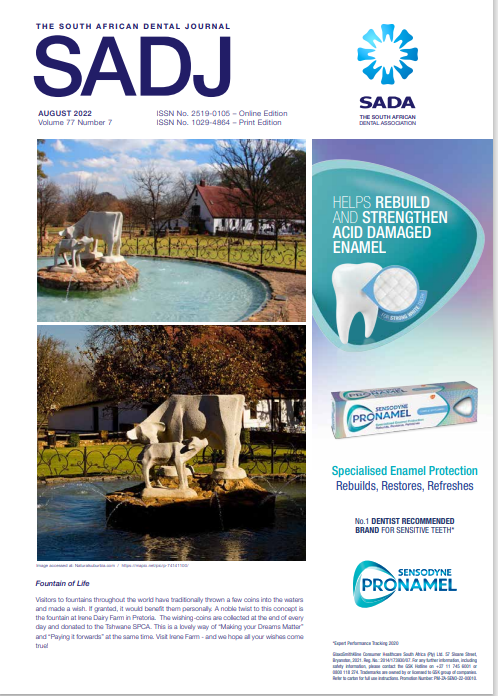Pre-empting and preventing iatrogenic oral trauma: A case report
DOI:
https://doi.org/10.17159/2519-0105/2022/v77no7a6Keywords:
maxillary, autonomyAbstract
In keeping with the principles of autonomy, beneficence, and non-maleficence, no dental treatment shouldbbe commenced prior to carrying out all the requisite preparatory stages. This includes a thorough initial assessment, establishing an accurate diagnosis,
drawing up a list of possible treatment options, presenting these to the patient, and allowing them to make an autonomous and educated decision. This should be followed with the formulation of a structured and carefully considered treatment plan.This case illustrates a case of iatrogenically induced damage suffered by a patient where unplanned treatment was carried out
with no consideration of the possible immediate, short term or long terms outcomes. It stresses the need for dentists to consider and pre-empt the consequences of their treatment (or lack there-of) and formulate the best possible plan for each patient. It also needs to be stressed that the proposed management plan must be informed by the principle of ‘shared decision making’ wherein the patient assumes part of the responsibility and accountability in the decisions taken. The ultimate aim of any plan must be to promote the best possible outcome for the patient (beneficence), and as far as possible prevent iatrogenically induced harm (non maleficence).
Downloads
References
Benjamin SD. Oral diagnosis in the general practice. Compendium of continuing education in dentistry. 2011. Vol 32(2). Accessed at: https:// www.aegisdentalnetwork.com/cced/specialissues/2011/09/oral-diagnosis-in-the-generalpractice. Accessed on: 02-08-2021
Mersel A. Immediate or transitional complete dentures: Gerodontic considerations. International dental journal. 2002. Aug; 2(4):298-303.
Cobb AC. Complete treatment planning: Meeting patients’ needs. Inside dentistry. 2015. Vol 11. Issue 8.
Newsome P, Smales R., and Yip K. Oral diagnosis and treatment planning: Part 1. Introduction. Br Dent J. 2012. Vol213, No 1;15-20.
Ahmad I. Risk management in clinical practice. Part 5. Ethical considerations for dental enhancement procedures. Br Dent J 2010. Sep;209 (5):207-14.
Laney WR and Gibilisco, JA. Diagnosis and treatment planning in prosthodontics.1983. Ed Lea and Febiger; Philadelphia. Ch 9; pg208-215
Dalal S, Shetty O, Mistry G. Occlusal splints. International J of Dental and Medical Sciences (IOSR-JDMS). 2018.52-3.
Day J and Stream S. Ethics in the Dental Office: Autonomy, beneficence, non-maleficence, and justice should guide your decisions. Dental
Assistant. 2018. Jul 1;87 (4):8-9.
Beauchamp TI and Childress, JF. 2001. Principles of biomed
Downloads
Published
Issue
Section
License

This work is licensed under a Creative Commons Attribution-NonCommercial 4.0 International License.






.png)